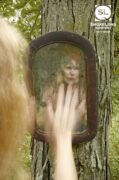I love how this story borrows a variety of forms, genres, and emotional landscapes—we get the secrecy of Mona Awad’s Bunny, the wit of Legally Blonde, the complex interiority of Jennifer Wortman’s This. This. This. Is Love. Love. Love., and much more. What creative work inspired you and led you to this piece?
I recently devoured everything Miranda July has written, and I think that act gave me absurd confidence to write without self-consciousness in form, in point of view, in language, in voice, in surrealism. Her work often moves between reality and fantasy seamlessly, as if there each were the same as the other—and I was so jealous of that, I wanted to try my hand at it. Recently I’ve also been consuming a lot of flash that plays with time, with the compression and expansion of it—pieces that come to mind being “A Brief Excerpt from the History of Salt” by Venita Blackburn, “Going for a Beer” by Robert Coover, “estuaries” by Aliceanna Stopher, “Miracles” by Lucy Corin, and anything from Wild Milk by Sabrina Orah Mark.
When I teach flash fiction, I often teach that many good flash pieces are pulling from a toolbox of effective techniques—things like compression, immediacy, inventiveness, relentlessness, and surprise. Like many well-written pieces, your story utilizes several of these, but the one that I was most drawn to was your use of compression. This piece uses parentheses as a mechanism for moving back and forth between the external and internal worlds of the protagonist, and it also imparts tremendous information when it does so. How did you make the decision to structure the story this way? What else did you have to consider or wrestle with as you were writing this piece?
At some point in the process of writing this story, a more traditional format (paragraph breaks, no run-on sentences, no parenthetical interiority) became unwieldy—the story didn’t sit well in that form. During revision I wrestled the narrative into a block of text, doing away with the prison of paragraphs, in an effort to let form fit function. I wanted the compression of exterior and interior to mirror the breathlessness/chaos/absurdity/emotional complexity of this moment. I also wanted to present a parallel fantasy, one where the character can pull up a chair and speak plainly, addressing the discomfort in conformity that she thinks all the rest must be feeling, throwing off the confines of being a follower, declaring her difference, her queerness—and the best place for that was burrowed into the immediate action, held in by parentheses. I felt like they had to be simultaneous. My hope in this form was that the reader—already involved in the story because of the second person perspective—would feel implicated too in their own ideas of belonging, conformity, and speaking the unspoken.
Your story centers around a young woman’s experience during a sorority initiation, but it also layers in the complexity of a young woman who is simultaneously grappling with her sexuality. I loved this, and I also wondered: why did you feel called to bring this character to this particular moment of realization while she was in this situation? Are you trying to communicate anything in particular about queerness and/or belonging?
When I set out to write this story, I wanted to interrogate the absurd way that sororities and fraternities define belonging, and how it complicates other kinds of belonging—to oneself, to one’s body, to one’s values, to a queer community, to the world. The belonging Greek life offers is often an illusion: flimsy, surface-level, based on debasement and degradation. What would it look like to force this group-identity on a character struggling with her own sexual identity? A sticky frat basement felt to me like a weird and thrilling place for a vulnerable sorority pledge to consider her queer desires—desires that might place her at odds with the ways in which Greek groups often perpetuate heteronormative and sexist values. I stuck her in front of acne-riddled frat pledges, said “now kiss,” and thought about how explosive this would make her feel if it was really the girl next to her that she wanted to kiss. How do you belong to yourself in a group that asks you to belong to a singular idea? How do you find multiplicity in that place? I was eager to parse through the possibilities there.
I would read much more work from the perspective of the people in this story. What do you think a piece from the perspective of one of the fraternity boys might look like?
Writing this from the perspective of a frat pledge would be another exhilarating chance to talk about belonging, about feeling misplaced, about being forced into a box of conformity. What an opportunity to think about the ways that fraternities perpetuate toxic masculinity, how a young man stuck in this cycle would either have to join in or jump ship: no in-between. And no doubt the acne-riddled boys in this line are having silent identity-struggles of their own. I would eagerly dig into their heads: What are those gritty self-doubts? Scuffles with sexuality? Concerns of body image? Questions of family, of friendship, of presenting himself to the world as the right kind of man? I want a beer-bloated boy, scared for his life. It’s his freshman year of college and this is where he’s ended up: lined up as a kissing-object, against his own will. What multiplicity does he wish he could embody?



 The core workshop of SmokeLong Fitness is all in writing, so you can take part from anywhere at anytime. We are excited about creating a supportive, consistent and structured environment for flash writers to work on their craft in a community. We are thrilled and proud to say that our workshop participants have won, placed, or been listed in every major flash competition. Community works.
The core workshop of SmokeLong Fitness is all in writing, so you can take part from anywhere at anytime. We are excited about creating a supportive, consistent and structured environment for flash writers to work on their craft in a community. We are thrilled and proud to say that our workshop participants have won, placed, or been listed in every major flash competition. Community works.